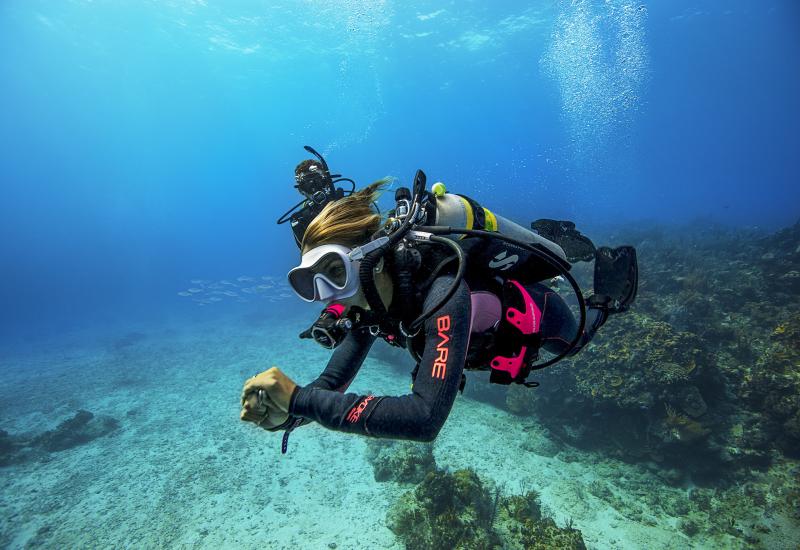Florida and Florida Keys Lobstering Guide
 |
An epidemic of lust, greed and envy is about to claim tens of thousands of Florida divers. It's called bug fever and it strikes during mini-season every year on the last Wednesday and Thursday of July — the start of Florida spiny lobster season. There are two Florida lobster seasons — the two-day mini season and the eight-month regular lobster season. The mini lobster season is always the last consecutive Wednesday and Thursday in July. It begins at 12:01 a.m. on Wednesday and ends at 12 a.m. (midnight) on Thursday. The regular eight-month lobster season is always August 6 through March 31.
In the grasp of bug fever, divers who are normally content to breathe deep, swim slow and look at pretty fishies, suddenly desire the competitive thrill of the hunt and the sweet taste of victory — grilled or boiled, and served with butter.
There is no cure, though regular doses of compressed air administered on lobster-rich reefs provide temporary relief. In most cases, lobster fever burns out by Labor Day, but sporadic outbreaks can occur well into March wherever legal-size crawfish are found.
Feel a case coming on? You're not alone. Which is why you need these expert tips on surviving lobster season without hurting your pride, yourself or the reef.
The Tools You'll Need
-
Dive Flag - All divers in Florida waters must display a dive flag and stay within 300 feet of open water.
-
Short-Handled Lobster Net and Tail Snare - Nets are used on sand flats while snares are best for reefs.
-
Tickle Stick - A thin fiberglass rod about 24 inches long used to coax lobsters out of holes without harming the reef.
-
Gloves - For the lobster, not the reef.
-
Mesh Game Bag - To hold your catch. Look for models with a convenient way to attach to your weight belt or gear, and a locking enclosure.
-
Lobster Gauge - Every diver must carry a lobster gauge and must measure the lobster under water before it's placed in the game bag.
The Season
Florida lobster season opens with a two-day recreational mini-season that's your chance to catch the biggest tails before commercial fishermen set their traps. The competitive advantage is minimized by the fact that as many as 50,000 other divers invade the state's reefs during this intense 48 hours and the hunt takes on the fevered pitch of a gold rush. Another 62,000 or so will join their hunt starting in August, the start of the regular season, which runs until March.
 |
The Playing Field
While you can catch Florida spiny lobsters from Pensacola to Key West, the heaviest concentrations are found in three areas.
The Florida Keys
Monroe County boasts the largest lobster population in the state and draws the most lobster divers. More than 70 percent of all crawfish taken in the state come from reefs in Monroe County, despite the fact that lobster hunting is regulated more strictly here than anywhere else. During the mini-season, for example, bag limits are smaller and lobster diving at night is illegal, but that doesn't stop the masses from filling every hotel, campground, marina and charter boat available.
Obviously, no-take zones, such as those in the Florida Keys National Marine Sanctuary (marked by yellow buoys), John Pennekamp State Park, Looe Key Sanctuary and the Biscayne Bay-Card Sound Lobster Sanctuary are off-limits. But almost every other dive site is open to lobster hunting.
The Middle Keys, from Islamorada to Marathon, are considered the prime hunting grounds. From Islamorada, lobster charters visit reef sites including The Garden, Fish Bowl and the Aquarium. From Marathon, try the Bomb Holes, a series of shallow craters on the Florida Bay side of Marathon; the current-swept pilings and rubble piles of the Seven-Mile Bridge; and shallow reefs like Herman's Hole and Yellow Rocks.
Key West lobster dive charters head to the reefs of The Sambos and Dry Rocks. The lobster frenzy largely bypasses Key Largo and that's just fine with local divers who stay away from popular diving reefs and look for lobster on unnamed patch reefs and sand flats.
The Gold Coast
While the reefs of Dade, Broward and Palm Beach counties don't draw the crowds that the Keys do, the Gold Coast has numerous lobster-rich sites, and bug hunting is taken every bit as seriously here as it is in the Keys. The mini-season rules are looser, and because it's legal to dive at night for lobster, some dive operators offer a round-the-clock charter schedule.
From Miami Beach north, bug hunting starts right at the beach. Off South Beach, you'll find legal-size lobster within 50 yards of the sand, or you can join lobster charters to natural reefs, ledges, grass beds and man-made, state-approved rubble reefs.
In Broward and Palm Beach, the first reef line is an easy swim from shore and holds plenty of bugs at the beginning of the season. Local charter boats also take divers to productive sites farther offshore. Beach Inlet and deep ledges off Jupiter Inlet are popular bug sites. Charters out of Palm Beach Inlet offer a selection of both deep ledges and shallow reef lines that hold plenty of big bugs for drift divers.
The East Coast
From Vero Beach to Jacksonville, local bug hunters have countless secret spots, and lobster season is a cause for celebration — with shore dives and three-tank hunting trips to offshore sites. In the Daytona area, try the shore-accessible reefs of Jaycee Beach or catch a charter to the Turtle Mound. Off Jacksonville/St. Augustine, charters hit deep offshore sites like Elton Bottom and Clayton's Holler.
 |
The Target
 |
The secret to successful lobster hunting is understanding your quarry. Some key facts about the Florida spiny lobster, aka, Panulirus argus, bug or crawfish.
Distinguishing features - 10 sharp-pointed walking legs and no pincer claws. Spines projecting from the hard shell and "horns" located above each eye for protection. A pair of whip-like conical antennae longer than the body.
Habitat -Reefs, grass beds and sand flats from three to 130 feet, hiding by day under ledges and in holes; feeding in the open at night.
Size - Generally six to 10 inches and about one pound. May grow as long as two feet and weigh more than 10 pounds. A one-pound whole spiny lobster yields approximately one-third of a pound of cooked lobster meat.
Mating and reproduction - Mating takes place March through July. Females carry clusters of fertilized eggs beneath the abdomen for about three weeks before they hatch.
Behavior - Wary. Spinies retreat into crevices when approached or swim backward quickly when disturbed, keeping their antennae pointed at threats.
 |
Where Lobsters Come From
The lobster that ends up on your plate fresh off a Florida Keys reef may have begun its life as far away as South America.
1. Planktonic larvae arrive via the Loop Current, which moves up from South America and the Caribbean Sea, around the Gulf of Mexico and into the Florida Straits, where it joins the Florida Current to create the Gulf Stream.
After hatching from eggs, the flat, transparent larvae drift in ocean currents for up to nine months, passing through 11 stages of development before changing into a transparent, lobster-like puerulus stage.
2. Free swimming inch-long pueruli migrate shoreward, aided by counterclockwise currents, and settle in a variety of shallow, nearshore habitats in the Keys and Florida Bay. There, they molt into juveniles within a few days.
3. Juveniles reach reproductive maturity in about three years, moving from bayside nurseries to seaward reefs as they approach adulthood.
Catch 'Em If You Can: Tips and Techniques
If you're new to lobster diving, there's something you should know before you fire up the grill in anticipation.
It ain't easy.
"It's mentally challenging because you have to find them and it's physically challenging because you have to catch them," says avid lobster diver John Conley. "The first time you try, you will generally be unsuccessful. It does take a little persistence, but once you catch that first one, everything instantly clicks."
Finding Them
Tip - Look closely. You won't find a lobster out in the open, especially during the day when they hole up inside reef crevices and refuse to budge.
Technique - Look for antennae waving out from holes in the reef, or bring a light to peer in crevices. Look for eels, which tend to like the same reef crevices as lobster.
Catching Them
Tip -Think like a lobster. Lobster retreat from danger by moving backward. Use this knowledge to your advantage.
Technique -Rather than grabbing at them by hand, successful hunters use tickle sticks and other tools to coax the animals into backing into their nets or snares.
Tip -Use the right tool for the job. If a lobster is holed-up inside the reef or rubble, your net won't do much good and probably a lot of harm."Nets are good out in the sand but they're just so hard on the reef. People don't think about how much damage a $20 lobster net can do to a million-year-old reef," says Teague. She recommends using a tail snare and tickle stick.
Technique -Sneak the noose behind the lobster while you distract it with the tickle stick. When the loop is in place, conduct your prey backward and through the loop. Tighten the snare and pull your catch out of the hole.
If the bug is under an open ledge, in the grass or on the sand, tickle the lobster out into the open by sliding the stick past the bug and nudging it on the tail. The bug will turn to face the threat. Place your net behind the tail and use the tickle stick to scare the bug into scooting backward into the net.
Tip - Don't let it escape. The hardest part of lobster diving is keeping your catch.
Technique - When you coax a lobster into your net, quickly fold the net over the frame to prevent the lobster from escaping while you measure it and check for eggs. Transferring your catch to the mesh game bag is also tricky. Open your game bag just wide enough to get the lobster in tail-first. When you release the snare, the bug will jet backward into the bag. With a net, grab the lobster through the net with one hand and hold the game bag open with the other. Guide the lobster into the bag tail-first.
Tip - Get a good grip. Grab a thrashing lobster by the tail and it will easily break your grasp. And a panicked lobster will gladly sacrifice an antennae or leg in a bid for freedom.
Technique -Use gloves and handle lobster by the carapace only.
The Rules
Lobster is Florida's most important commercial seafood, and state laws regulating the harvest — designed to give the lobster a fighting chance to reproduce — are strictly enforced, especially during peak times of the mini and early regular season.
Primary responsibility for enforcement falls on the officers of the Florida Fish and Wildlife Conservation Commission (FWC), but any sworn officer can enforce the laws and during peak season they call in reinforcements. Expect to see officers out in force on the water, at marinas, in the air, and manning checkpoints at strategic locations.
During crunch time, they adopt a zero tolerance policy toward violations of game collecting or boating safety. "We're not out to 'get' people or anything like that, but it is a busy enforcement time," says spokesman Amanda Nalley.
The most common violations are exceeding bag limits, making multiple trips and taking undersized lobsters, says Capt. George Steinmetz. Violations are second-degree misdemeanors and are punishable by up to $500 in fines and six months in jail, not to mention possible forfeiture of your dive gear.
To stay on the right side of the law:
Get a clue. Look for the information center on Hwy. 1 in Key Largo. Game officers will be on hand to answer questions, show you the correct way to measure a lobster, and point out no-take zones to avoid. Maps, pamphlets and advice are also available at any dive store or tackle shop. You can learn the rules and regs by visiting the FWC web site at http://myfwc.com/about/rules-regulations/.
Get a license. You must have a valid Florida saltwater fishing license with a current lobster stamp. Available at tackle shops, some dive stores, or online from FWC on its recreational licenses page. You can also call toll-free (from U.S. and Canada): 888-FISH-FLORIDA (347-4356).
Get a measurement. All spiny lobster must be measured under water using a lobster gauge before you put them in your game bag and must be kept whole until you reach the dock. Length from between the eyes to the start of the tail must be longer than the opening of the gauge, or you don't have a keeper.
Check for eggs. Game laws prohibit the taking of egg-bearing females. Fortunately, they're easy to spot. Before bagging a legal-size bug, flip the lobster over and look for orange-colored caviar. Females carrying eggs must be put back unharmed.
Know your bag limits.
Monroe County mini season: 6 per diver per day. No night diving for lobster.
Monroe County regular season: 6 per diver per day.
Outside Monroe County: 12 per diver/day mini season and 6 per diver/day regular season.
You Caught It, You Cook It
Catching a spiny lobster is the hard part. Cleaning and cooking are a breeze.
To Clean: Keep your catch alive in a cooler with a few inches of salt water until you're almost ready to cook them, then twist the tails off. Remove the alimentary canal and rinse with fresh water. When the tail is clean, put it on ice, or freeze it for later.
To Cook: Grill, boil it or try one of these local recipes.
Annette's Special
Cut off the underside shell of the tail with kitchen shears. Coat the exposed meat with butter, lemon and garlic. Place on grill, fins-side down, for about five minutes and then flip. Meat is done when white and firm. Serve with lemon and butter.
— Capt. Spencer Slate
Atlantis Dive Center, Key Largo
Uncle David's Honey Lobster
Cut tails in half and place in a small loaf pan. Drizzle on butter, garlic salt and a squirt of honey. Place pan on grill and cook until the meat is white and firm — timed at approximately two frosty beverages. Peel out the meat and dip into the drippings in the pan.
— Gloria Teague
Islamorada
|| |---|
|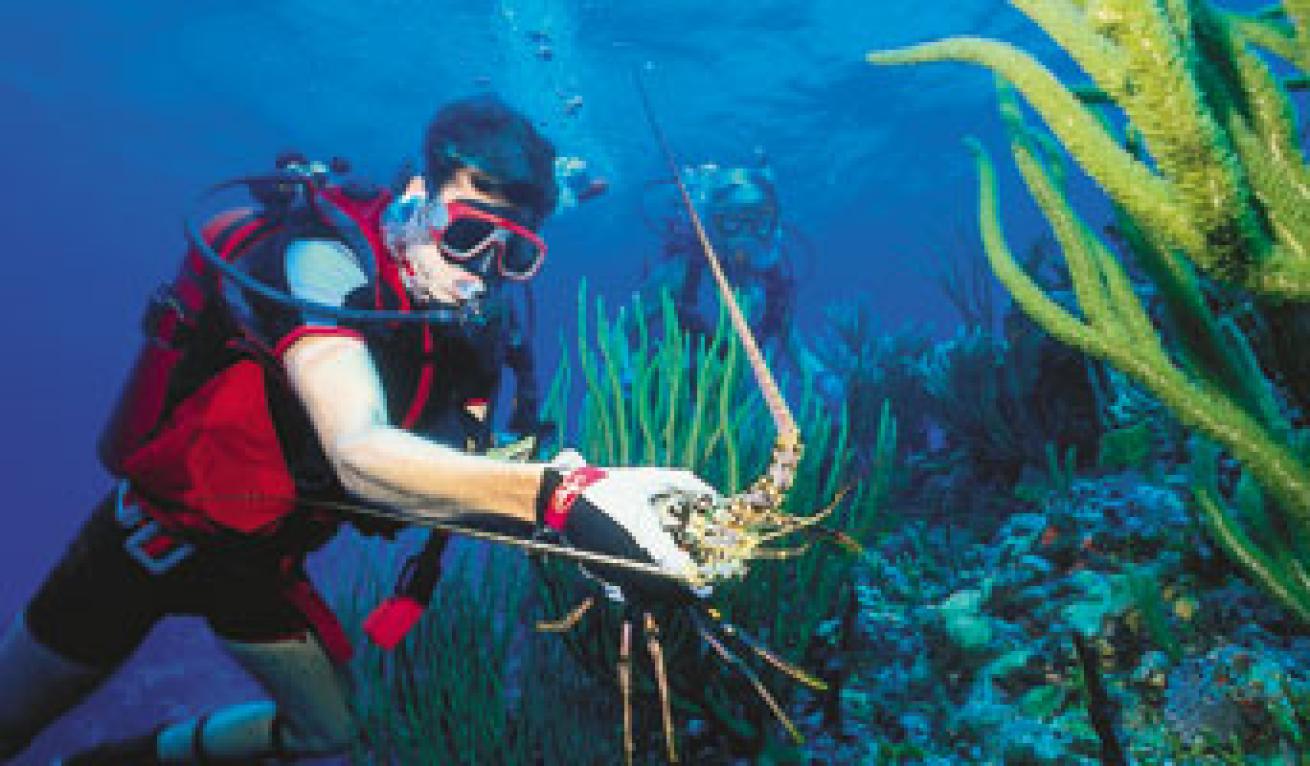
|
An epidemic of lust, greed and envy is about to claim tens of thousands of Florida divers. It's called bug fever and it strikes during mini-season every year on the last Wednesday and Thursday of July — the start of Florida spiny lobster season. There are two Florida lobster seasons — the two-day mini season and the eight-month regular lobster season. The mini lobster season is always the last consecutive Wednesday and Thursday in July. It begins at 12:01 a.m. on Wednesday and ends at 12 a.m. (midnight) on Thursday. The regular eight-month lobster season is always August 6 through March 31.
In the grasp of bug fever, divers who are normally content to breathe deep, swim slow and look at pretty fishies, suddenly desire the competitive thrill of the hunt and the sweet taste of victory — grilled or boiled, and served with butter.
There is no cure, though regular doses of compressed air administered on lobster-rich reefs provide temporary relief. In most cases, lobster fever burns out by Labor Day, but sporadic outbreaks can occur well into March wherever legal-size crawfish are found.
Feel a case coming on? You're not alone. Which is why you need these expert tips on surviving lobster season without hurting your pride, yourself or the reef.
The Tools You'll Need
Dive Flag - All divers in Florida waters must display a dive flag and stay within 300 feet of open water.
Short-Handled Lobster Net and Tail Snare - Nets are used on sand flats while snares are best for reefs.
Tickle Stick - A thin fiberglass rod about 24 inches long used to coax lobsters out of holes without harming the reef.
Gloves - For the lobster, not the reef.
Mesh Game Bag - To hold your catch. Look for models with a convenient way to attach to your weight belt or gear, and a locking enclosure.
Lobster Gauge - Every diver must carry a lobster gauge and must measure the lobster under water before it's placed in the game bag.
The Season
Florida lobster season opens with a two-day recreational mini-season that's your chance to catch the biggest tails before commercial fishermen set their traps. The competitive advantage is minimized by the fact that as many as 50,000 other divers invade the state's reefs during this intense 48 hours and the hunt takes on the fevered pitch of a gold rush. Another 62,000 or so will join their hunt starting in August, the start of the regular season, which runs until March.
|| |---|
|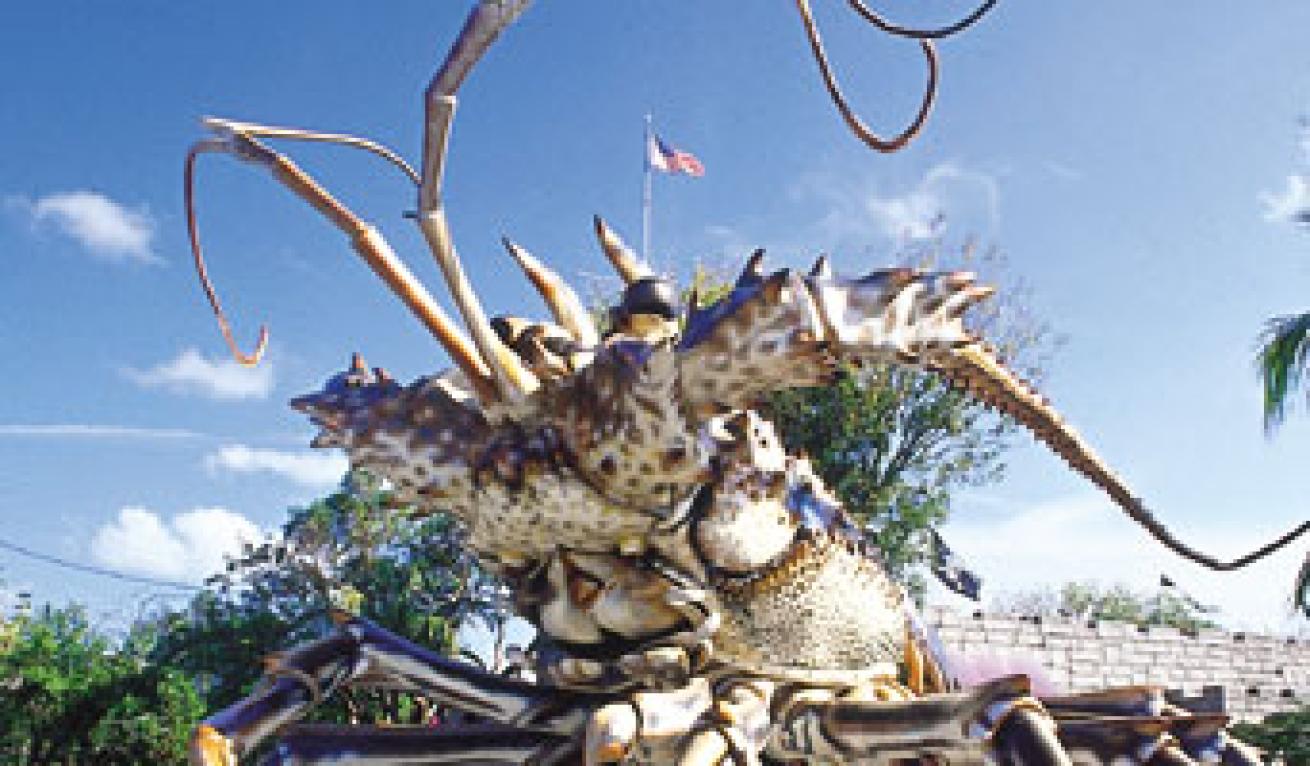
|
The Playing Field
While you can catch Florida spiny lobsters from Pensacola to Key West, the heaviest concentrations are found in three areas.
The Florida Keys
Monroe County boasts the largest lobster population in the state and draws the most lobster divers. More than 70 percent of all crawfish taken in the state come from reefs in Monroe County, despite the fact that lobster hunting is regulated more strictly here than anywhere else. During the mini-season, for example, bag limits are smaller and lobster diving at night is illegal, but that doesn't stop the masses from filling every hotel, campground, marina and charter boat available.
Obviously, no-take zones, such as those in the Florida Keys National Marine Sanctuary (marked by yellow buoys), John Pennekamp State Park, Looe Key Sanctuary and the Biscayne Bay-Card Sound Lobster Sanctuary are off-limits. But almost every other dive site is open to lobster hunting.
The Middle Keys, from Islamorada to Marathon, are considered the prime hunting grounds. From Islamorada, lobster charters visit reef sites including The Garden, Fish Bowl and the Aquarium. From Marathon, try the Bomb Holes, a series of shallow craters on the Florida Bay side of Marathon; the current-swept pilings and rubble piles of the Seven-Mile Bridge; and shallow reefs like Herman's Hole and Yellow Rocks.
Key West lobster dive charters head to the reefs of The Sambos and Dry Rocks. The lobster frenzy largely bypasses Key Largo and that's just fine with local divers who stay away from popular diving reefs and look for lobster on unnamed patch reefs and sand flats.
The Gold Coast
While the reefs of Dade, Broward and Palm Beach counties don't draw the crowds that the Keys do, the Gold Coast has numerous lobster-rich sites, and bug hunting is taken every bit as seriously here as it is in the Keys. The mini-season rules are looser, and because it's legal to dive at night for lobster, some dive operators offer a round-the-clock charter schedule.
From Miami Beach north, bug hunting starts right at the beach. Off South Beach, you'll find legal-size lobster within 50 yards of the sand, or you can join lobster charters to natural reefs, ledges, grass beds and man-made, state-approved rubble reefs.
In Broward and Palm Beach, the first reef line is an easy swim from shore and holds plenty of bugs at the beginning of the season. Local charter boats also take divers to productive sites farther offshore. Beach Inlet and deep ledges off Jupiter Inlet are popular bug sites. Charters out of Palm Beach Inlet offer a selection of both deep ledges and shallow reef lines that hold plenty of big bugs for drift divers.
The East Coast
From Vero Beach to Jacksonville, local bug hunters have countless secret spots, and lobster season is a cause for celebration — with shore dives and three-tank hunting trips to offshore sites. In the Daytona area, try the shore-accessible reefs of Jaycee Beach or catch a charter to the Turtle Mound. Off Jacksonville/St. Augustine, charters hit deep offshore sites like Elton Bottom and Clayton's Holler.
|| |---|
|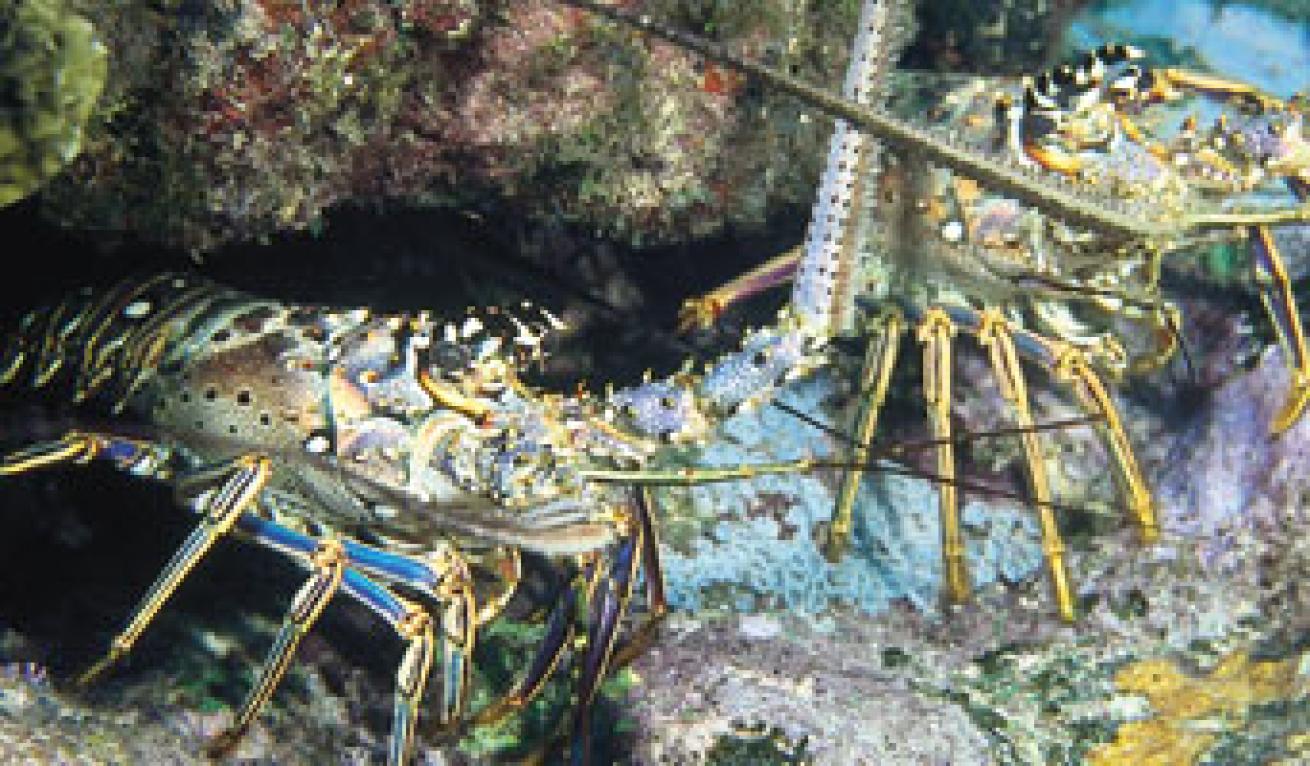
|
The Target
|| |---|
|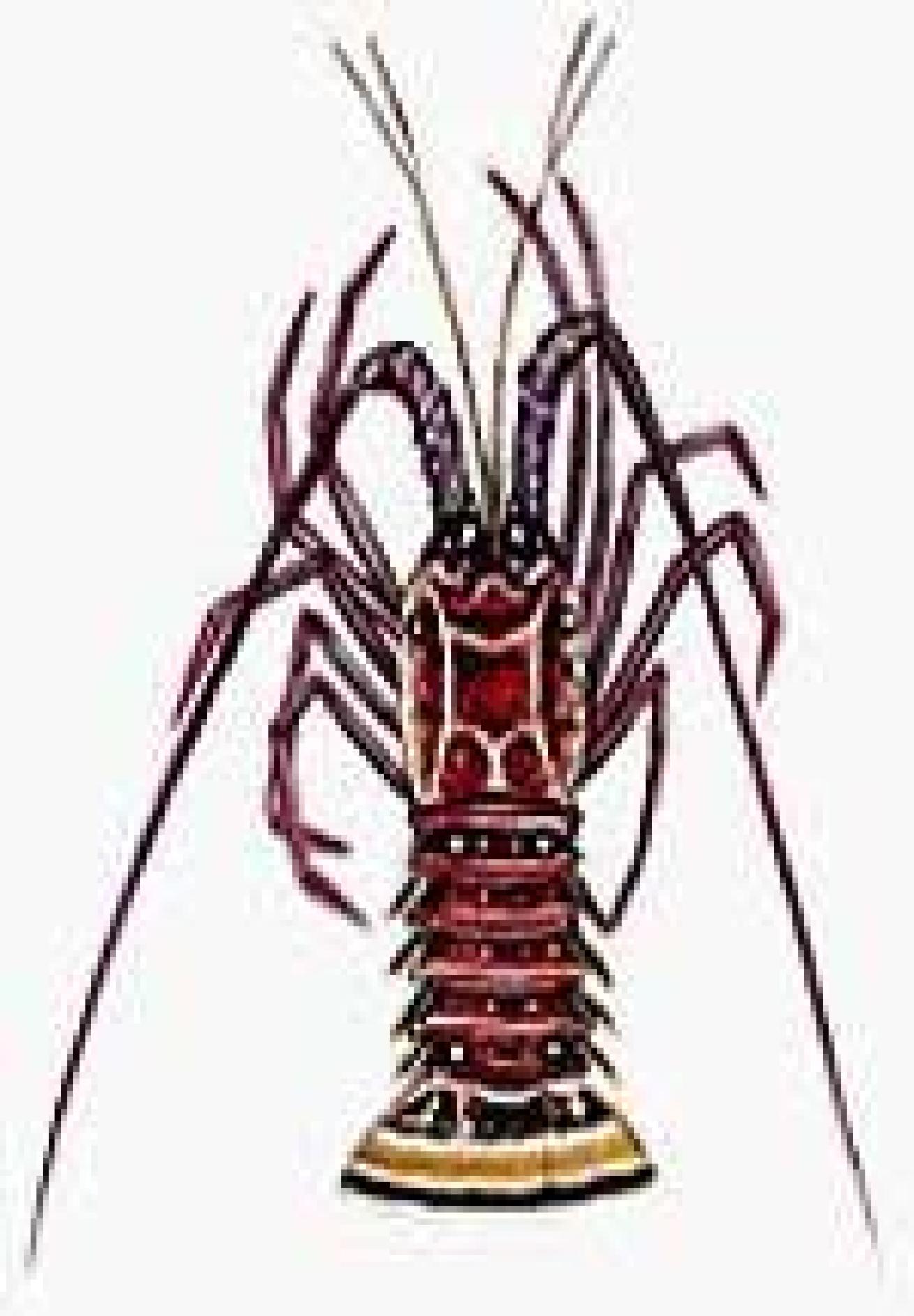
|
The secret to successful lobster hunting is understanding your quarry. Some key facts about the Florida spiny lobster, aka, Panulirus argus, bug or crawfish.
Distinguishing features - 10 sharp-pointed walking legs and no pincer claws. Spines projecting from the hard shell and "horns" located above each eye for protection. A pair of whip-like conical antennae longer than the body.
Habitat -Reefs, grass beds and sand flats from three to 130 feet, hiding by day under ledges and in holes; feeding in the open at night.
Size - Generally six to 10 inches and about one pound. May grow as long as two feet and weigh more than 10 pounds. A one-pound whole spiny lobster yields approximately one-third of a pound of cooked lobster meat.
Mating and reproduction - Mating takes place March through July. Females carry clusters of fertilized eggs beneath the abdomen for about three weeks before they hatch.
Behavior - Wary. Spinies retreat into crevices when approached or swim backward quickly when disturbed, keeping their antennae pointed at threats.
|| |---|
|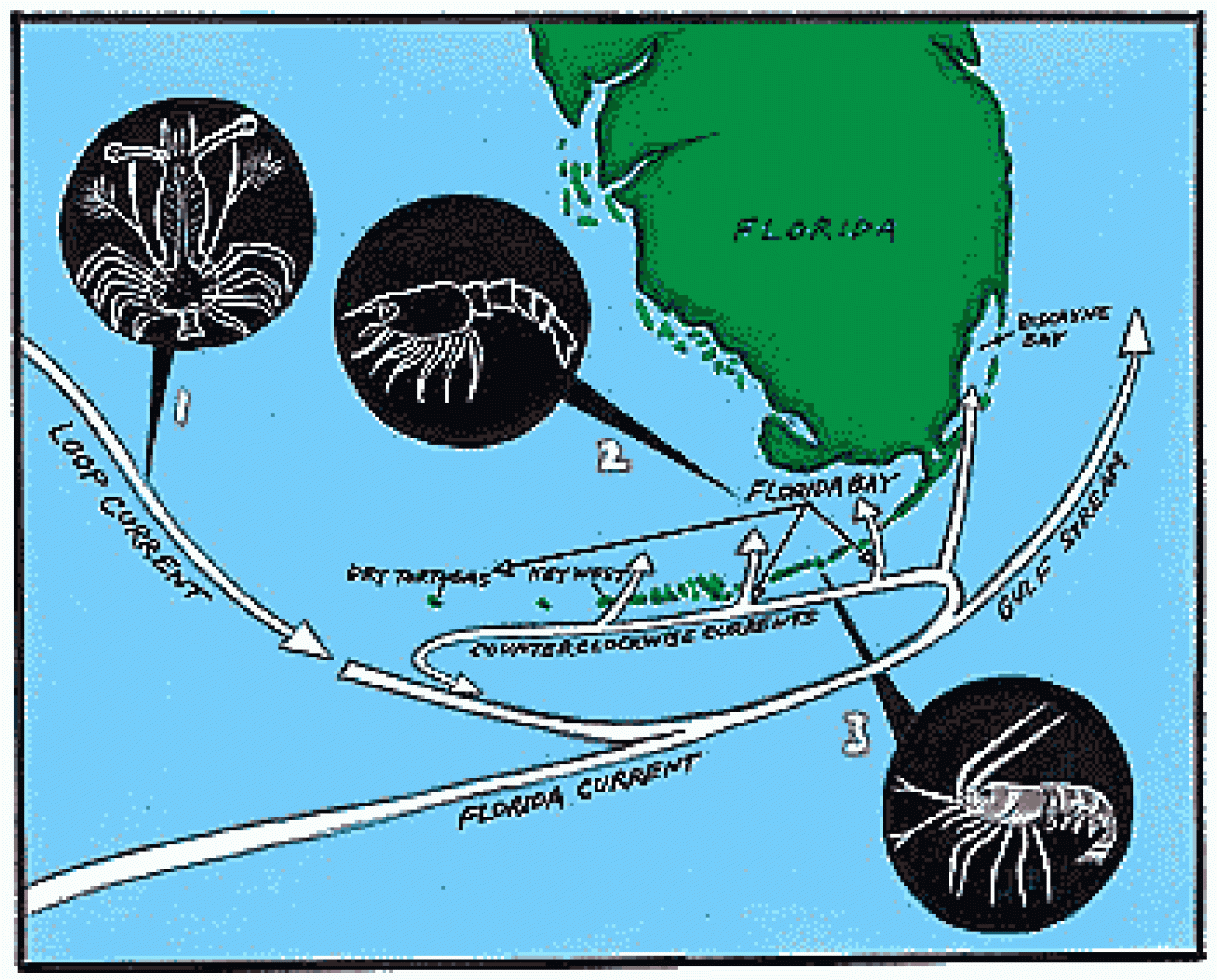
|
Where Lobsters Come From
The lobster that ends up on your plate fresh off a Florida Keys reef may have begun its life as far away as South America.
1. Planktonic larvae arrive via the Loop Current, which moves up from South America and the Caribbean Sea, around the Gulf of Mexico and into the Florida Straits, where it joins the Florida Current to create the Gulf Stream.
After hatching from eggs, the flat, transparent larvae drift in ocean currents for up to nine months, passing through 11 stages of development before changing into a transparent, lobster-like puerulus stage.
2. Free swimming inch-long pueruli migrate shoreward, aided by counterclockwise currents, and settle in a variety of shallow, nearshore habitats in the Keys and Florida Bay. There, they molt into juveniles within a few days.
3. Juveniles reach reproductive maturity in about three years, moving from bayside nurseries to seaward reefs as they approach adulthood.
Catch 'Em If You Can: Tips and Techniques
If you're new to lobster diving, there's something you should know before you fire up the grill in anticipation.
It ain't easy.
"It's mentally challenging because you have to find them and it's physically challenging because you have to catch them," says avid lobster diver John Conley. "The first time you try, you will generally be unsuccessful. It does take a little persistence, but once you catch that first one, everything instantly clicks."
Finding Them
Tip - Look closely. You won't find a lobster out in the open, especially during the day when they hole up inside reef crevices and refuse to budge.
Technique - Look for antennae waving out from holes in the reef, or bring a light to peer in crevices. Look for eels, which tend to like the same reef crevices as lobster.
Catching Them
Tip -Think like a lobster. Lobster retreat from danger by moving backward. Use this knowledge to your advantage. Technique -Rather than grabbing at them by hand, successful hunters use tickle sticks and other tools to coax the animals into backing into their nets or snares.
Tip -Use the right tool for the job. If a lobster is holed-up inside the reef or rubble, your net won't do much good and probably a lot of harm."Nets are good out in the sand but they're just so hard on the reef. People don't think about how much damage a $20 lobster net can do to a million-year-old reef," says Teague. She recommends using a tail snare and tickle stick.
Technique -Sneak the noose behind the lobster while you distract it with the tickle stick. When the loop is in place, conduct your prey backward and through the loop. Tighten the snare and pull your catch out of the hole.
If the bug is under an open ledge, in the grass or on the sand, tickle the lobster out into the open by sliding the stick past the bug and nudging it on the tail. The bug will turn to face the threat. Place your net behind the tail and use the tickle stick to scare the bug into scooting backward into the net.
Tip - Don't let it escape. The hardest part of lobster diving is keeping your catch.
Technique - When you coax a lobster into your net, quickly fold the net over the frame to prevent the lobster from escaping while you measure it and check for eggs. Transferring your catch to the mesh game bag is also tricky. Open your game bag just wide enough to get the lobster in tail-first. When you release the snare, the bug will jet backward into the bag. With a net, grab the lobster through the net with one hand and hold the game bag open with the other. Guide the lobster into the bag tail-first.
Tip - Get a good grip. Grab a thrashing lobster by the tail and it will easily break your grasp. And a panicked lobster will gladly sacrifice an antennae or leg in a bid for freedom.
Technique -Use gloves and handle lobster by the carapace only.
The Rules
Lobster is Florida's most important commercial seafood, and state laws regulating the harvest — designed to give the lobster a fighting chance to reproduce — are strictly enforced, especially during peak times of the mini and early regular season.
Primary responsibility for enforcement falls on the officers of the Florida Fish and Wildlife Conservation Commission (FWC), but any sworn officer can enforce the laws and during peak season they call in reinforcements. Expect to see officers out in force on the water, at marinas, in the air, and manning checkpoints at strategic locations.
During crunch time, they adopt a zero tolerance policy toward violations of game collecting or boating safety. "We're not out to 'get' people or anything like that, but it is a busy enforcement time," says spokesman Amanda Nalley.
The most common violations are exceeding bag limits, making multiple trips and taking undersized lobsters, says Capt. George Steinmetz. Violations are second-degree misdemeanors and are punishable by up to $500 in fines and six months in jail, not to mention possible forfeiture of your dive gear.
To stay on the right side of the law:
Get a clue. Look for the information center on Hwy. 1 in Key Largo. Game officers will be on hand to answer questions, show you the correct way to measure a lobster, and point out no-take zones to avoid. Maps, pamphlets and advice are also available at any dive store or tackle shop. You can learn the rules and regs by visiting the FWC web site at http://myfwc.com/about/rules-regulations/.
Get a license. You must have a valid Florida saltwater fishing license with a current lobster stamp. Available at tackle shops, some dive stores, or online from FWC on its recreational licenses page. You can also call toll-free (from U.S. and Canada): 888-FISH-FLORIDA (347-4356).
Get a measurement. All spiny lobster must be measured under water using a lobster gauge before you put them in your game bag and must be kept whole until you reach the dock. Length from between the eyes to the start of the tail must be longer than the opening of the gauge, or you don't have a keeper.
Check for eggs. Game laws prohibit the taking of egg-bearing females. Fortunately, they're easy to spot. Before bagging a legal-size bug, flip the lobster over and look for orange-colored caviar. Females carrying eggs must be put back unharmed.
Know your bag limits.
Monroe County mini season: 6 per diver per day. No night diving for lobster.
Monroe County regular season: 6 per diver per day.
Outside Monroe County: 12 per diver/day mini season and 6 per diver/day regular season.
You Caught It, You Cook It
Catching a spiny lobster is the hard part. Cleaning and cooking are a breeze.
To Clean: Keep your catch alive in a cooler with a few inches of salt water until you're almost ready to cook them, then twist the tails off. Remove the alimentary canal and rinse with fresh water. When the tail is clean, put it on ice, or freeze it for later.
To Cook: Grill, boil it or try one of these local recipes.
Annette's Special
Cut off the underside shell of the tail with kitchen shears. Coat the exposed meat with butter, lemon and garlic. Place on grill, fins-side down, for about five minutes and then flip. Meat is done when white and firm. Serve with lemon and butter.
— Capt. Spencer Slate
Atlantis Dive Center, Key Largo
Uncle David's Honey Lobster
Cut tails in half and place in a small loaf pan. Drizzle on butter, garlic salt and a squirt of honey. Place pan on grill and cook until the meat is white and firm — timed at approximately two frosty beverages. Peel out the meat and dip into the drippings in the pan.
— Gloria Teague
Islamorada

